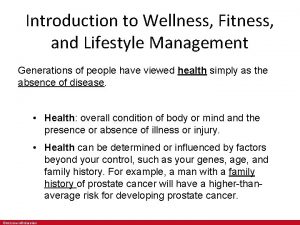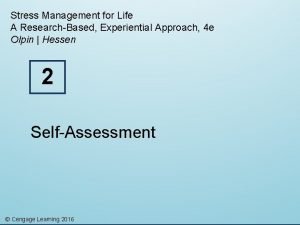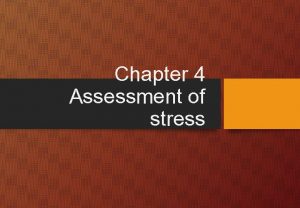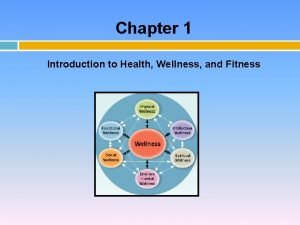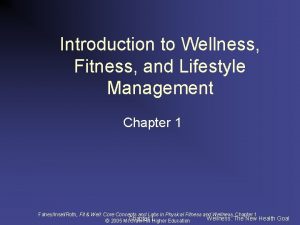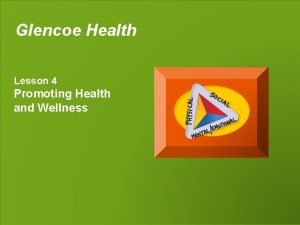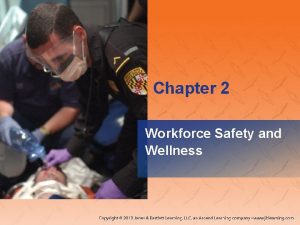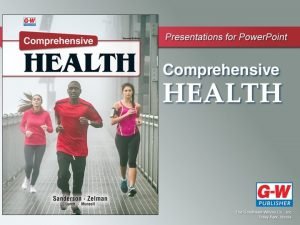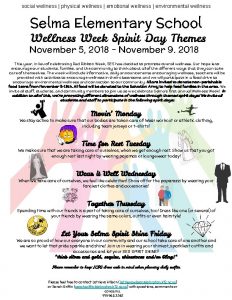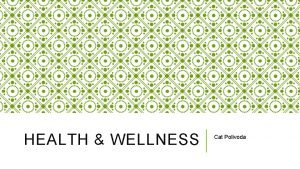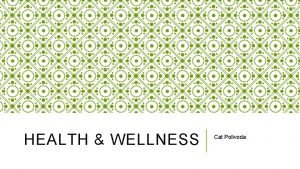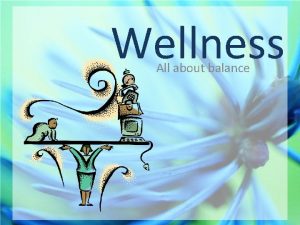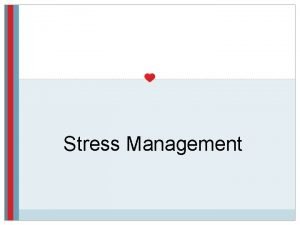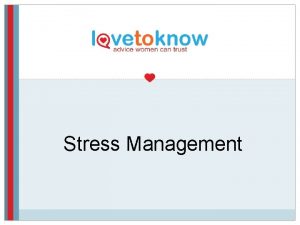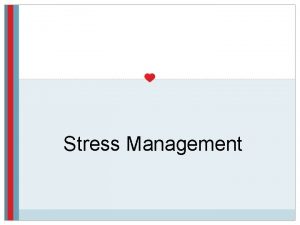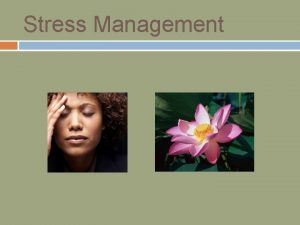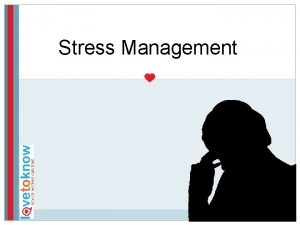Wellness Stress Management Chapter 1 Introduction Introduction Stress















- Slides: 15

Wellness Stress Management

Chapter 1 Introduction

Introduction • Stress is a necessary part of individuals’ daily lives (to force us to accomplish certain tasks) which is unavoidable part of lives. • Stress can be simple or extreme. • The effect stress will have depends on how individuals handle or view the situation. • Without stress, the bodies wouldn't react at all, even in times of extreme danger. • Successfully manage stress can do much to improve individuals’ mental and physical health. The Harvard Health Publication, 2013

Definition: Stress is… • Anything that stimulates individuals to have stress experiences and to act, think, or react. • Any event-environment/internal demands or both tax or exceed the adaptive resources of an individual, social system, or tissue system. • Lazarus (1966): Stress arises when individuals perceive that they cannot adequately cope with the demands being made on them or with threats to their well-being Eustress- Good stress • Selye: Non specific response of the body to any kind of Distress. Bad Stress demand made upon it.

Impact of Stress • 60 -80% of outpatient visits may be related to stress (Rosch, 1991; Avey, Matheny, Robbins, & Jacobson, 2003) • Linked to all leading physical causes of death - heart disease, cancer, stroke (Cohen, Janicki-Deverts, & Miller, 2007) • Associated with development of most major mental health problems – depression, PTSD, pathologic aging (Marin et al. , 2011) • Affects fetal development & outcomes (Kinsella & Monk, 2009) • Predicts negative health behaviors and relapses–


• Health • Wellness • Health is optimal well-being that contributes • Wellness to quality reflects how of life. one feels about life as as one’s ability to • It is more than freedom from disease andwell illness, though freedom from disease is importantfunction to goodeffectively. health. • Optimal health includes high-level mental, social, emotional, spiritual, and physical wellness within the limits of one’s heredity and personal abilities. • Healthy days

Wellness • • • The integration of 5 components: Mental, social, emotional, spiritual, and physical that expand one’s potential to live (quality of life) and work effectively and make a significant contribution to society. Reflects how one feels (a sense of well-being) about life as well as one’s ability to function effectively. Is the positive component of

Wellness reflects how one feels about life As well as one’s ability to function effectively.

Chapter 2 Classification of stress

Classification of stress by severity Stress Levels Low Stress Optimum Stress High Stress Reactions -Bordom/Apathy -High energy -Exhaustion Behaviors -Low motivation -Carelessness -Psychological withdraw -Inactivity -High motivation -Heightened perception -High involvement -Anxiety -Nervousness Indecisiveness -Bad judgement Performance -Low performance -High performance -Poor performance Health effects -Good health -Insomnia - -Dull health

Classification of stress by duration • Most common form • Acute Stress • Chronic Stress • It comes from demands and pressures of the recent • This of is the past and anticipated demands and pressures the grinding stress that wears people near future. away day after day, year • Acute stress is thrilling and exciting in small doses, after year. but too much is exhausting. • It comes when a person never sees a way out of a miserable situation. With no hope, the individual gives up searching for 2014) solutions. (Miller & Smiths,


Classification of stress Level 1 Immediate stress • Increased heart rate and blood pressure • Rapid breathing • Perspiring and sweaty palms • Indigestion and nervous stomach Level 2 Level 3 Continued stress Ongoing stress • Feelings of being pressured or driven • Exhaustion and fatigue • Anxiety • Memory loss • Colds and flu • Increase in smoking or • Insomnia • Errors in judgment • Personality changes • Autoimmune disorders • Heart disease • Mental illness (Bay, 2010)

 Chapter 10 stress responses and stress management
Chapter 10 stress responses and stress management Introduction to wellness fitness and lifestyle management
Introduction to wellness fitness and lifestyle management Ardell wellness stress test
Ardell wellness stress test Ardell wellness stress test
Ardell wellness stress test Coaching activity introduction to health and wellness
Coaching activity introduction to health and wellness Wellness and lifestyle management
Wellness and lifestyle management True stress and engineering stress
True stress and engineering stress Normal stress definition
Normal stress definition Organization change and stress management
Organization change and stress management Glencoe health and wellness
Glencoe health and wellness Goodheart willcox chapter 1 answers
Goodheart willcox chapter 1 answers Lesson 4 promoting health and wellness
Lesson 4 promoting health and wellness Chapter 2 workforce safety and wellness
Chapter 2 workforce safety and wellness Understanding your health and wellness chapter 1
Understanding your health and wellness chapter 1 Understanding your health and wellness
Understanding your health and wellness Chapter 1 understanding health and wellness lesson 2
Chapter 1 understanding health and wellness lesson 2

